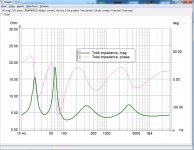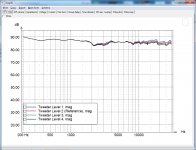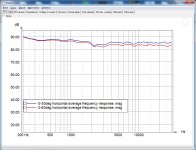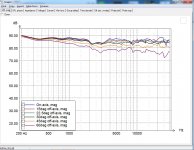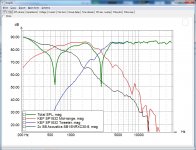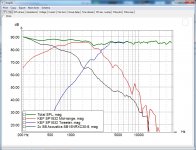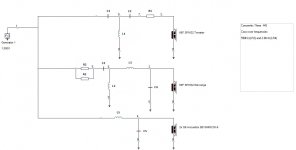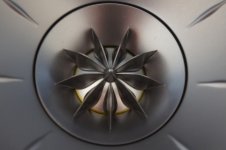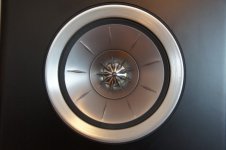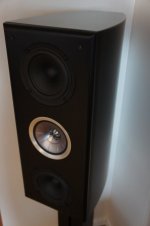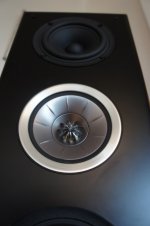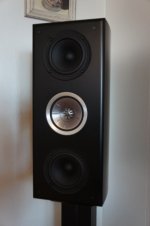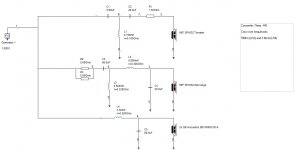Hi everyone,
I’m currently working on a small 3-way based around the KEF SP1632 co-axial driver paired with dual SB Acoustics 5” mid-woofers.
The design is called Concentric Three – M5 and I thought I should share the construction progress for those who are interested.
The KEF SP1632 is a great sounding little driver with several nice features like a braced aluminium/magnesium mid-range cone for suppression of cone break-ups as well as a wave-guide like feature for the aluminium tweeter dome.
Here are more details on the construction as well as detailed measurements on the driver units:
Concentric Three – M5 Construction!
KEF SP1632 Measurements!
SB Acoustics SB15NRXC30-8 Measurements!
Note! The KEF SP1632 driver isn’t generally available to DIY:ers. Either it has to be stripped from a loudspeaker in the “R Series” or ordered as a spare part, but this requires a valid “R Series” serial number in order to be able to obtain the driver.
Regards
/Göran
I’m currently working on a small 3-way based around the KEF SP1632 co-axial driver paired with dual SB Acoustics 5” mid-woofers.
The design is called Concentric Three – M5 and I thought I should share the construction progress for those who are interested.
The KEF SP1632 is a great sounding little driver with several nice features like a braced aluminium/magnesium mid-range cone for suppression of cone break-ups as well as a wave-guide like feature for the aluminium tweeter dome.
Here are more details on the construction as well as detailed measurements on the driver units:
Concentric Three – M5 Construction!
KEF SP1632 Measurements!
SB Acoustics SB15NRXC30-8 Measurements!
Note! The KEF SP1632 driver isn’t generally available to DIY:ers. Either it has to be stripped from a loudspeaker in the “R Series” or ordered as a spare part, but this requires a valid “R Series” serial number in order to be able to obtain the driver.
Regards
/Göran
Attachments
-
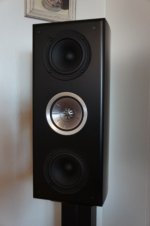 Picture1.jpg75.7 KB · Views: 1,036
Picture1.jpg75.7 KB · Views: 1,036 -
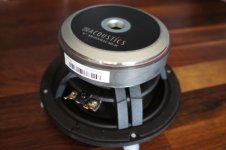 Picture10.jpg87.7 KB · Views: 268
Picture10.jpg87.7 KB · Views: 268 -
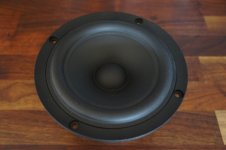 Picture9.jpg83.3 KB · Views: 340
Picture9.jpg83.3 KB · Views: 340 -
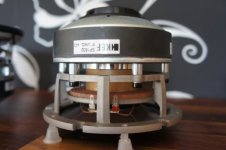 Picture8.jpg89 KB · Views: 344
Picture8.jpg89 KB · Views: 344 -
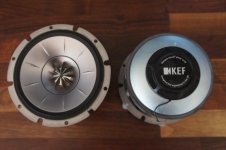 Picture7.jpg92.3 KB · Views: 234
Picture7.jpg92.3 KB · Views: 234 -
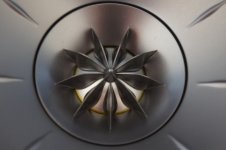 Picture6.jpg82.6 KB · Views: 179
Picture6.jpg82.6 KB · Views: 179 -
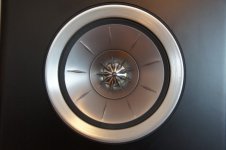 Picture5.jpg87.2 KB · Views: 973
Picture5.jpg87.2 KB · Views: 973 -
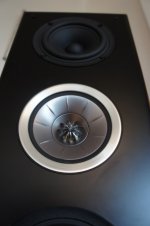 Picture4.jpg79.5 KB · Views: 989
Picture4.jpg79.5 KB · Views: 989 -
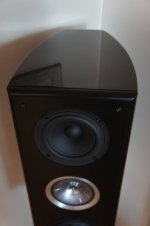 Picture3.jpg73.2 KB · Views: 985
Picture3.jpg73.2 KB · Views: 985 -
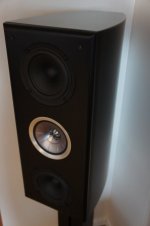 Picture2.jpg75.1 KB · Views: 1,025
Picture2.jpg75.1 KB · Views: 1,025
Concentric Three – M5 Construction Update 1!
For you who are interested in the KEF concentric drivers!
I’ve now finished the cross-over simulation and I’m moving on to the next stage of building the first cross-over prototype and starting the listening tests.
The cross-over:
Picture1:The cross-over is very simple and uses a LR4 filter topology (acoustical) between the tweeter and mid and a LR2 topology (acoustical) between the mid and woofer. The cross-over consist of only 12 parts and all sections are second-order electrically, besides the tweeter section which is third-order electrically in order to achieve an acoustical LR4 frequency roll-off.
Note! The woofer’s are connected with reverse polarity.
The tweeter level can be adjusted by changing the value of the single resistor R1. R2 and R3 can be replaced with one resistor if it can handle >20W.
I don’t reveal the actual component values until I’ve evaluated the cross-over prototype. The cross-over schematic is only used here to inform how the cross-over looks like. Depending on the listening tests and further measurements it can be changed little or completely.
Frequency response:
The cross-over simulation is based on the drivers 15deg off-axis measurements.
Picture2: 15deg off-xis frequency response (no smoothing applied).
Picture3: 15deg off-xis frequency response with mid-range reverse polarity.
The mid-range driver has a built in “BBC” response dip between 2-3.5kHz. The tweeter has a very extended and smooth frequency response, especially considering that this is a co-axial driver unit. The loudspeaker has a system sensitivity of about 88dB @ 2.83v/1m.
When reversing the mid-range polarity we can see very deep notches around 590Hz and 2.8kHz at the cross-over frequencies. The deep notches indicate a very good phase response tracking and summation between the driver units around the cross-over frequency.
Picture4: Frequency response 0-60deg (no smoothing applied).
Picture5: The frequency response curve is an average of four measurements (blue): on-axis, 15, 22.5 & 30deg and six measurements (red): on-axis, 15, 22.5, 30, 45 & 60deg.
The loudspeaker has a smooth power response with a slightly downwards tilting response at higher frequencies. The tweeter has an extended frequency response with very wide off-axis dispersion.
Picture6: Four different tweeter levels.
Picture7: System impedance simulation.
The resistor R1 can be changed to fine tune the tweeter level. The level 2 is the “reference” level used in the above frequency and cross-over simulations. The minimum impedance occurs @ 120Hz and is slightly below 3 Ohms. The system sensitivity of 88dB @ 2.83v/1m is mainly achieved by the low impedance driver units used in the loudspeaker.
Summation:
As I've written before on my blog, I don’t intend to make a clone of any of KEF’s loudspeakers and I don’t have a clue how the cross-over for KEF’s loudspeakers looks like, even though my chosen cross-over frequencies seems rather similar to those used in the R500 loudspeaker. It just happens to be very suitable frequencies to cross-over at. I would say that a suitable cross-over window is about +/- 100Hz from that I have chosen, at least the drivers seems to be engineered in that way.
With that said, the KEF driver is really great and I’m eagerly waiting for the cross-over components I’ve ordered for the first prototype and I can’t wait to have a listen to the Concentric Three – M5 loudspeaker!
For further details on the construction and driver unit measurements see:
Concentric Three – M5 Construction Update 1!
Concentric Three – M5 Construction!
KEF SP1632 Measurements!
SB Acoustics SB15NRXC30-8 Measurements!
The KEF R500 loudspeaker using the same mid/tweeter and similar sized woofer’s:
Hi-Fi Speakers - R Series - Fact Sheets - Floorstanding - R500 - KEF International
Independent KEF R500 loudspeaker measurements:
SoundStage - KEF R500 Measurements!
Regards
/Göran
For you who are interested in the KEF concentric drivers!
I’ve now finished the cross-over simulation and I’m moving on to the next stage of building the first cross-over prototype and starting the listening tests.
The cross-over:
Picture1:The cross-over is very simple and uses a LR4 filter topology (acoustical) between the tweeter and mid and a LR2 topology (acoustical) between the mid and woofer. The cross-over consist of only 12 parts and all sections are second-order electrically, besides the tweeter section which is third-order electrically in order to achieve an acoustical LR4 frequency roll-off.
Note! The woofer’s are connected with reverse polarity.
The tweeter level can be adjusted by changing the value of the single resistor R1. R2 and R3 can be replaced with one resistor if it can handle >20W.
I don’t reveal the actual component values until I’ve evaluated the cross-over prototype. The cross-over schematic is only used here to inform how the cross-over looks like. Depending on the listening tests and further measurements it can be changed little or completely.
Frequency response:
The cross-over simulation is based on the drivers 15deg off-axis measurements.
Picture2: 15deg off-xis frequency response (no smoothing applied).
Picture3: 15deg off-xis frequency response with mid-range reverse polarity.
The mid-range driver has a built in “BBC” response dip between 2-3.5kHz. The tweeter has a very extended and smooth frequency response, especially considering that this is a co-axial driver unit. The loudspeaker has a system sensitivity of about 88dB @ 2.83v/1m.
When reversing the mid-range polarity we can see very deep notches around 590Hz and 2.8kHz at the cross-over frequencies. The deep notches indicate a very good phase response tracking and summation between the driver units around the cross-over frequency.
Picture4: Frequency response 0-60deg (no smoothing applied).
Picture5: The frequency response curve is an average of four measurements (blue): on-axis, 15, 22.5 & 30deg and six measurements (red): on-axis, 15, 22.5, 30, 45 & 60deg.
The loudspeaker has a smooth power response with a slightly downwards tilting response at higher frequencies. The tweeter has an extended frequency response with very wide off-axis dispersion.
Picture6: Four different tweeter levels.
Picture7: System impedance simulation.
The resistor R1 can be changed to fine tune the tweeter level. The level 2 is the “reference” level used in the above frequency and cross-over simulations. The minimum impedance occurs @ 120Hz and is slightly below 3 Ohms. The system sensitivity of 88dB @ 2.83v/1m is mainly achieved by the low impedance driver units used in the loudspeaker.
Summation:
As I've written before on my blog, I don’t intend to make a clone of any of KEF’s loudspeakers and I don’t have a clue how the cross-over for KEF’s loudspeakers looks like, even though my chosen cross-over frequencies seems rather similar to those used in the R500 loudspeaker. It just happens to be very suitable frequencies to cross-over at. I would say that a suitable cross-over window is about +/- 100Hz from that I have chosen, at least the drivers seems to be engineered in that way.
With that said, the KEF driver is really great and I’m eagerly waiting for the cross-over components I’ve ordered for the first prototype and I can’t wait to have a listen to the Concentric Three – M5 loudspeaker!
For further details on the construction and driver unit measurements see:
Concentric Three – M5 Construction Update 1!
Concentric Three – M5 Construction!
KEF SP1632 Measurements!
SB Acoustics SB15NRXC30-8 Measurements!
The KEF R500 loudspeaker using the same mid/tweeter and similar sized woofer’s:
Hi-Fi Speakers - R Series - Fact Sheets - Floorstanding - R500 - KEF International
Independent KEF R500 loudspeaker measurements:
SoundStage - KEF R500 Measurements!
Regards
/Göran
Attachments
Concentric Three - M5 Finished!
Hi everyone!
Finally I've finished the Concentric Three – M5 design. It has actually been finished for some time now and I enjoy and like it very much.
If comparing with the commercial KEF loudspeakers, the Concentric Three – M5 speaker most closely resembles the 2600$ KEF R500 design in size and driver unit layout.
The KEF SP1632 co-axial driver is truly an amazing driver and delivers top notch performance to a budget price.
I have a couple of times listened on the KEF R500 and they instantly caught my interest, but I haven’t actually listened to my design side by side with the KEF R500 so I can’t comment on the exact sonic differences between them.
One thing I can say is that as a DIY designer I don’t have to compromise with the cross-over design in order to cut costs as most commercial loudspeaker manufacturer have to do, at least in this loudspeaker price range.
It would however be interesting if anyone out there has the cross-over schematics for the KEF SP1632 driver used in the KEF loudspeaker “R series” in order to compare the design choices made.
If you do please let me know!
For further details on my design see: Concentric Three - M5
Regards
/Göran
Hi everyone!
Finally I've finished the Concentric Three – M5 design. It has actually been finished for some time now and I enjoy and like it very much.
If comparing with the commercial KEF loudspeakers, the Concentric Three – M5 speaker most closely resembles the 2600$ KEF R500 design in size and driver unit layout.
The KEF SP1632 co-axial driver is truly an amazing driver and delivers top notch performance to a budget price.
I have a couple of times listened on the KEF R500 and they instantly caught my interest, but I haven’t actually listened to my design side by side with the KEF R500 so I can’t comment on the exact sonic differences between them.
One thing I can say is that as a DIY designer I don’t have to compromise with the cross-over design in order to cut costs as most commercial loudspeaker manufacturer have to do, at least in this loudspeaker price range.
It would however be interesting if anyone out there has the cross-over schematics for the KEF SP1632 driver used in the KEF loudspeaker “R series” in order to compare the design choices made.
If you do please let me know!
For further details on my design see: Concentric Three - M5
Regards
/Göran
Attachments
Where can i buy this Kef driver ?
Is it a spare part or did you salvage it from a KEF speaker ?
Hi Joachim!
You got a PM!
Regards
/Göran
Gornir, if you are continuing to use these and have further impressions, I'd love to hear. You've built exactly the kind of speaker I'm interested in making or buying for my medium-sized room. We don't have a KEF dealer in Austin so it's tough to find R300s to listen to. But your D'Applolito style array is of more interest to me anyway. Looks really impressive.
Any thoughts as to whether the same speaker on its side would work as a center? I've heard the KEF-style drivers have similar dispersion upright or horizontal.
Any thoughts as to whether the same speaker on its side would work as a center? I've heard the KEF-style drivers have similar dispersion upright or horizontal.
PS - Gornir, I'm also interested in what you wrote about the R300 coaxial:
I notice the Q100s crossover (per KEF) at 2.5kHz. Do you detect any problems there? Sounds like that is working well from your take on the speakers.
One thing though, I wouldn't use the tweeter much below 2.5kHz, because it starts to distort like crazy below that. Distortion is of no issue if the tweeter cross-over is around 2.8-3kHz.
I notice the Q100s crossover (per KEF) at 2.5kHz. Do you detect any problems there? Sounds like that is working well from your take on the speakers.
Gornir, if you are continuing to use these and have further impressions, I'd love to hear. You've built exactly the kind of speaker I'm interested in making or buying for my medium-sized room. We don't have a KEF dealer in Austin so it's tough to find R300s to listen to. But your D'Applolito style array is of more interest to me anyway. Looks really impressive.
Any thoughts as to whether the same speaker on its side would work as a center? I've heard the KEF-style drivers have similar dispersion upright or horizontal.
Hi,
Yes I still use them and they are one of my favorite speakers. The are quite bass heavy and shouldn't be placed to close to the back wall, besides that they sound very smooth, pure and effortless.
You can use it as an center placed on its side, but then I would build it with a closed box option.
Regards
/Göran
I notice the Q100s crossover (per KEF) at 2.5kHz. Do you detect any problems there? Sounds like that is working well from your take on the speakers.
The Q100 doesn't use the same co-axial driver as the R300, so I can't really comment on its capabilities.
/Göran
Göran a really interesting project. Are the Kef units available in the UK do you know?
I was considering a 6" 2 way floor standing design, but I'm limited to the physical size and width of my speakers that means a 5" driver would be better. Would there be merit in exploring your Prestigious Two DXT but as a 2.5 MTM design?
I was considering a 6" 2 way floor standing design, but I'm limited to the physical size and width of my speakers that means a 5" driver would be better. Would there be merit in exploring your Prestigious Two DXT but as a 2.5 MTM design?
Last edited:
Göran a really interesting project. Are the Kef units available in the UK do you know?
I was considering a 6" 2 way floor standing design, but I'm limited to the physical size and width of my speakers that means a 5" driver would be better. Would there be merit in exploring your Prestigious Two DXT but as a 2.5 MTM design?
Sorry, but I don't think you can get them in the UK.
You can find them here: Kef SP1632 Dual Concentric Driver Unit
To turn the "Prestigious Two – Monitor DXT" into a 2.5-way would require a different cross-over and I don't have any plans of doing such a design. This stand-mount speaker has a nice bass performance as it is.
If you want to transform it to a floor-stander with more bass, why not side mount a 8-10"sub-woofer and install a plate amp with an active cross-over in it?
Regards
/Göran
Hi Göran,
A pair of Kef SP1632's are around here; your design seems very nice.
Instead of SB15 I plan to use a pair of SB17NRXC35-8's in a monitor style closed box with Fb of some 60 Hz; two separate subs will do the fundamentals. SB17 has about the same T/S parameters; slightly higher sensitivity but there is room in the crossover for good matching.
I don't see what L2 is doing in the crossover as it will not do much in the 570 Hz high pass section; what am I missing?
Regards,
Pieter
A pair of Kef SP1632's are around here; your design seems very nice.
Instead of SB15 I plan to use a pair of SB17NRXC35-8's in a monitor style closed box with Fb of some 60 Hz; two separate subs will do the fundamentals. SB17 has about the same T/S parameters; slightly higher sensitivity but there is room in the crossover for good matching.
I don't see what L2 is doing in the crossover as it will not do much in the 570 Hz high pass section; what am I missing?
Regards,
Pieter
Hi Göran,
A pair of Kef SP1632's are around here; your design seems very nice.
Instead of SB15 I plan to use a pair of SB17NRXC35-8's in a monitor style closed box with Fb of some 60 Hz; two separate subs will do the fundamentals. SB17 has about the same T/S parameters; slightly higher sensitivity but there is room in the crossover for good matching.
I don't see what L2 is doing in the crossover as it will not do much in the 570 Hz high pass section; what am I missing?
Regards,
Pieter
Hi Pieter,
It does do a great deal! L2 shapes the high-pass section of the mid-range to a second-order (acoustical) Linkwitz-Riley topology. The same goes for the SB woofers low-pass section, hence why the woofers have a reverse polarity. The mid-range and tweeter section is a fourth-order (acoustical) Linkwitz-Riley topology.
In the attached picture you can see the effect of not using the L2 coil in the mid-range cross-over section. I wouldn't use the SP1632 mid-range without it since it can't take much low frequency abuse.
For cross-over details see Concentric Three - M5
Regards
/Göran
Attachments
Hi Göran,
Thanks, I see!
A friend of mine suggested to reverse all polarities; could also be done by switching plus and minus at the input of the crossover.
This to retain absolute phase in the bass which might be preferable.
What's your idea?
Regards,
Pieter
Hi,
No, I don't think so, but it's an easy thing try if you like it.
Regards
/Göran
If one were to be able to buy a replacement KEF1632 what do they cost?
About 175-225$ each.
/G
- Status
- This old topic is closed. If you want to reopen this topic, contact a moderator using the "Report Post" button.
- Home
- Loudspeakers
- Multi-Way
- Small 3-way with KEF SP1632 & SB Acoustics
